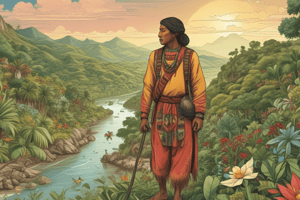Podcast
Questions and Answers
Which of the following tribes is associated with the conservation of specific rice cultivars such as Pattambi and Champara?
Which of the following tribes is associated with the conservation of specific rice cultivars such as Pattambi and Champara?
- Kurichya (correct)
- Santhal
- Birhor
- Munda
What is one characteristic in which the indigenous rice cultivars have been found to be genetically superior?
What is one characteristic in which the indigenous rice cultivars have been found to be genetically superior?
- Greater resistance to drought
- Faster growth rate
- Better aroma and grain quality (correct)
- Higher yield per acre
Which of the following regions is NOT mentioned as a location where indigenous communities conserve rice cultivars?
Which of the following regions is NOT mentioned as a location where indigenous communities conserve rice cultivars?
- Karnataka (correct)
- Assam
- Meghalaya
- Bihar
Which of the following types of wild species do ethnic people depend on for edible purposes?
Which of the following types of wild species do ethnic people depend on for edible purposes?
Which organization is involved in the multiplication of superior indigenous rice cultivars?
Which organization is involved in the multiplication of superior indigenous rice cultivars?
What is one primary way ethnic and indigenous people contribute to biodiversity conservation?
What is one primary way ethnic and indigenous people contribute to biodiversity conservation?
Which type of plants are commonly conserved by ethnic and indigenous communities?
Which type of plants are commonly conserved by ethnic and indigenous communities?
How are indigenous cultivars used in agricultural programs?
How are indigenous cultivars used in agricultural programs?
What unique knowledge do ethnic and indigenous people possess that aids in environmental management?
What unique knowledge do ethnic and indigenous people possess that aids in environmental management?
Which of the following does NOT represent the uses of plants conserved by ethnic people?
Which of the following does NOT represent the uses of plants conserved by ethnic people?
Where is in situ conservation commonly practiced by indigenous people?
Where is in situ conservation commonly practiced by indigenous people?
What characterizes the localities where indigenous and ethnic people typically reside?
What characterizes the localities where indigenous and ethnic people typically reside?
What aspect of indigenous people is highlighted as beneficial for living in harmony with nature?
What aspect of indigenous people is highlighted as beneficial for living in harmony with nature?
What percentage of the world’s biodiversity is conserved by ethnic people in India?
What percentage of the world’s biodiversity is conserved by ethnic people in India?
Which racial stock is NOT mentioned as part of the six racial stocks in India?
Which racial stock is NOT mentioned as part of the six racial stocks in India?
How many tribal communities exist in India?
How many tribal communities exist in India?
Which of the following is the number of plant species in India used for food by tribals?
Which of the following is the number of plant species in India used for food by tribals?
What is one of the uses of the 300 plant species extracted by tribals?
What is one of the uses of the 300 plant species extracted by tribals?
Which of the following plant parts are typically eaten raw according to the dietary practices of tribals?
Which of the following plant parts are typically eaten raw according to the dietary practices of tribals?
What is the number of ethnobotanically important species identified in India?
What is the number of ethnobotanically important species identified in India?
Which region in India is recognized as one of the biodiversity hotspots?
Which region in India is recognized as one of the biodiversity hotspots?
Which edible plant is harvested for its fruits, according to the list?
Which edible plant is harvested for its fruits, according to the list?
What part of Amorphophallus paenonflodium is used as a vegetable?
What part of Amorphophallus paenonflodium is used as a vegetable?
Which plant is noted for its use as an antidote for snake bites and scorpion stings?
Which plant is noted for its use as an antidote for snake bites and scorpion stings?
What action do tribals take to harvest Dioscorea tubers?
What action do tribals take to harvest Dioscorea tubers?
What is prepared from the rhizomes of some plants for medicinal purposes?
What is prepared from the rhizomes of some plants for medicinal purposes?
Which of the following plants is used by tribal herbal healers for orthopedic treatment?
Which of the following plants is used by tribal herbal healers for orthopedic treatment?
Which family does Aegle marmelos belong to?
Which family does Aegle marmelos belong to?
What are the seeds of Entada pursaetha used for?
What are the seeds of Entada pursaetha used for?
Which plant is used for treating muscular pain and other ailments?
Which plant is used for treating muscular pain and other ailments?
What common practice is associated with shifting agriculture among tribal societies?
What common practice is associated with shifting agriculture among tribal societies?
Which of the following plants is mentioned as being conserved for its significance in sacred groves?
Which of the following plants is mentioned as being conserved for its significance in sacred groves?
What role do herbal healers play in the conservation of plants according to the content?
What role do herbal healers play in the conservation of plants according to the content?
Which plant is NOT mentioned as having medicinal applications in the provided content?
Which plant is NOT mentioned as having medicinal applications in the provided content?
What is a primary benefit of the ashes collected from burnt biomass in shifting agriculture?
What is a primary benefit of the ashes collected from burnt biomass in shifting agriculture?
Which plant is specifically associated with treating white discharge in urine for tribal women?
Which plant is specifically associated with treating white discharge in urine for tribal women?
What does the practice of sacred groves primarily aim to achieve?
What does the practice of sacred groves primarily aim to achieve?
Flashcards are hidden until you start studying
Study Notes
Ethnic and Indigenous People & Biodiversity
- Ethnic and Indigenous People are biodiversity stewards. They have a deep and extensive understanding of natural resources and traditional knowledge of plant uses.
- India houses a vast ethnic community. There are 68 million people belonging to 227 ethnic groups and 573 tribal communities.
- Diverse plant uses. Indigenous peoples utilize over 7,500 plant species for medicinal purposes. Of these, 3,900 are eaten; 525 are used for fiber, 400 as fodder, 300 for chemical extraction, and 300 for gum, resins, dyes, and perfume.
Indigenous Cultivar Conservation
- Ethnic groups conserve diverse agricultural cultivars. They safeguard a rich diversity of rice, maize, millets, grains, legumes, fruits, and vegetables, originating in different climatic zones across India.
- Traditional genetic material. Indigenous cultivars often exhibit superior traits, such as aroma, grain quality, protein content, digestibility, and resistance to insects, pests, and diseases.
- Cultivar integration. Indigenous cultivars are incorporated into rice breeding programs to enhance existing varieties, conducted by institutions like the Central Rice Research Institute and the International Rice Research Institute.
Wild Edible Food
- Wild plants serve as a valuable food source. Ethnic communities rely on wild fruits, seeds, bulbs, roots, and tubers as edible staples.
- Traditional harvesting practices. Tribals utilize sustainable practices, such as harvesting tubers when leaves turn yellow, ensuring ecological prudence.
Medicinal Uses
- Plants serve as traditional remedies. Ethnic communities have a deep understanding of plant-based medicine and have used plants to treat various ailments. Examples include treatments for snakebites, scorpion stings, bone fractures, muscular pain, fever, and menstrual problems.
Conservation Methods
- Shifting agriculture. Jhoom farming practices, common in Northeast India, involve clearing forests and burning biomass. This creates temporary fields that are later abandoned to allow soil regeneration. Ethnic communities maintain valuable plant species during this process.
- Sacred Groves. Ethnic people often designate protected areas, sacred groves, where they actively conserve plant and animal life. This plays an important role in in-situ conservation of biodiversity.
Studying That Suits You
Use AI to generate personalized quizzes and flashcards to suit your learning preferences.




